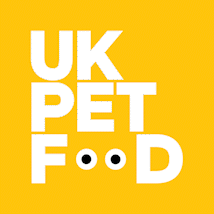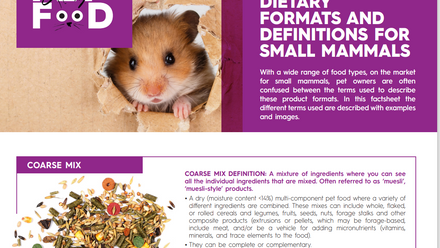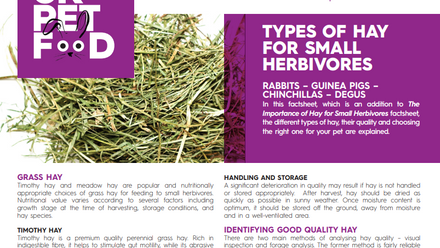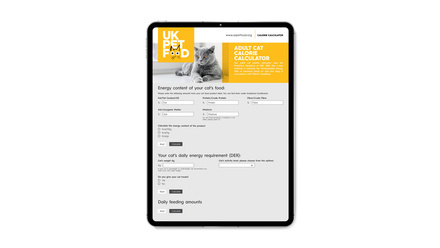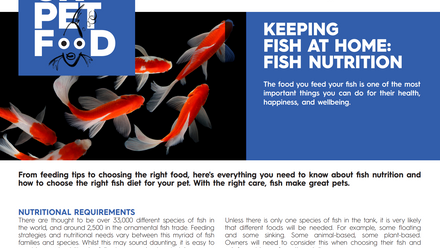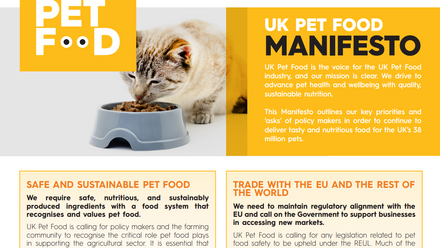The Different Pet Food Formats
In terms of which pet food format to feed, this very much comes down to the particular needs and preferences of an individual pet, along with what works well for the owner. Whilst some pets and their owners may prefer a wet food or a commercial raw food, others may prefer dry. This variety is intended to ensure there is something to suit all needs and preferences.
Wet Pet Food
Wet pet foods include cans, foil trays and pouches, with the contents including chunks in gravy, chunks in jelly, casserole and meatloaf formats. Wet pet foods have a high moisture content (approx 70-80%). They are sealed and then cooked at a defined temperature for sterilisation, which ensures safety and helps to maintain quality during shelf life.
Feeding considerations for wet foods
Wet food can be convenient with single-serve formats ensuring a fresh, easy-to-serve meal each time
• For hygiene and cleanliness any uneaten wet food should not be left out for a prolonged period of time
• Pets usually drink less when eating wet foods as there is higher water content than in dry foods
• Wet foods can be a good option for pets with missing teeth, poorly aligned jaws, or smaller mouths
• In terms of storage, once opened wet food can be kept for a maximum of up to 5-7 days if stored correctly. The food needs to be covered to minimise air exposure (for instance use a plastic tin lid or a zip-to-close bag) and refrigerated
• When feeding wet food, the portions will be bigger due to the higher water content
• A special consideration for puppies and large breed dogs: Puppies require a much higher nutrient intake per unit of their weight than an adult dog. Large breeds have proportionately smaller stomachs than standard or small breed dogs. In both these cases, it is possible that with wet food alone, a dog may feel full and finish his meal before the nutrient requirements have been met. To ensure your dog is receiving a nutritionally balanced diet, we advise owners to speak to their local vet for feeding advice.
Dry Pet Food
Dry pet foods may be extruded/baked (kibbles) or flaked. They have a lower moisture content than wet foods and are, therefore, fed in smaller quantities. Whilst dry foods normally have a higher level of carbohydrates, this does not prevent them from having the appropriate levels of protein to meet the pet’s nutritional needs in line with the FEDIAF Nutritional Guidelines.
Feeding considerations for dry pet foods
In terms of storage, dry pet foods should be stored in a cool, dry environment to prevent destruction of vitamins and oxidation of fats, which can lead to rancidity (spoilage). Pet foods will retain their best palatability if they’re stored in the original packaging, provided they are sealed properly after each use. Please refer to the ‘best before date’ on the pet food packet
• Dry pet foods are good for pets who like to eat little and often, and who choose to regularly return to their food.
• It can be left in the dish longer than wet food but it will become less palatable the longer it is left out
• Dry foods are convenient and can be weighed out more easily, helping with portion control
• Some, but not all, dry diets may contribute to dental health by reducing the build-up of plaque and tartar on the teeth
• Due to the lower moisture content in dry food (approx 8-10%) your pet is likely to drink more water. A recommendation is to offer one water bowl for each pet in the house plus an additional one. This is often referred to as the 1+1 rule
Commercial Raw Pet Food
In addition to wet and dry pet food, there is a range of commercially produced raw products available in frozen or freeze-dried formats. Raw pet food products can be complete or complementary. Complete diets will also contain a proportion of fruit, vegetables and sometimes herbs. Raw foods have a natural moisture content of approximately 65%. In terms of preparation, meat and edible bone are minced, mixed and then frozen at very low temperatures.
Feeding considerations for commercial raw pet foods
• Once defrosted it can be stored in the fridge if properly covered to minimise air exposure. The length of time for which it can be stored will vary between products and manufacturers will provide guidance on their packaging.
• Raw feeding does not use the ad-lib technique of leaving food down as can be done with dry feeding, instead it is offered at regular meal times
• For hygiene and cleanliness always ensure your hands, utensils, pet bowls and any surfaces that have come into contact with any raw pet foods are cleaned thoroughly, just as you would when handling raw meat for human consumption
• For hygiene and cleanliness any uneaten food should not be left out for a prolonged period of time
• Due to the high natural moisture content in raw food you may notice that your pet drinks less
• If switching from a dry or wet diet a gradual transition over 7-10 days is recommended to restore natural gastric acidity and allow the gut flora to adapt to a raw diet
Complete Pet Food
All ‘Complete’ pet foods for dogs and cats, regardless of format, are carefully formulated to provide all the nutrients a healthy pet needs. Members of the PFMA commit to formulating their diets in line with the FEDIAF Nutritional Guidelines1, which detail the nutritional needs of cats and dogs at varying life stages. These guidelines are peer-reviewed by independent veterinary nutrition experts throughout Europe, and they are updated to include the latest nutritional science.
How To Choose
The choice of what to feed is with the owner, depending on what they view as the best option for their pet and depending on any feeding advice provided by the vet. Many owners choose to ‘mix and match’ wet and dry foods. A pet with a clinical condition may be recommended a specific diet to assist with the management of the pet. Regardless of food type, a plentiful supply of fresh, clean drinking water should always be available. We advise all owners to follow the 1+1 rule (offer one water bowl for each pet in the house plus an additional one.) If you are concerned about any health issues, please contact your local vet.
